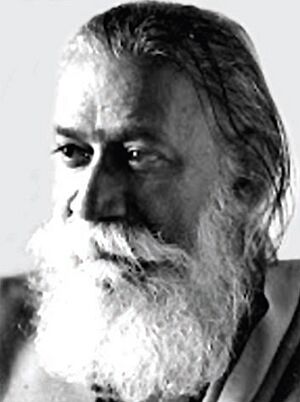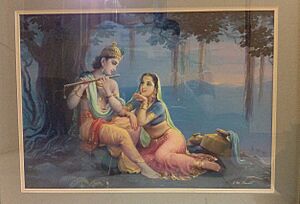S. M. Pandit facts for kids
Quick facts for kids
S. M. Pandit
|
|
|---|---|
 |
|
| Born | 25 March 1916 |
| Died | 30 March 1993 (aged 77) |
| Known for | Painting |
Sambanand Monappa Pandit (born March 25, 1916 – died March 30, 1993) was a famous Indian painter. He came from Karnataka state. He was known for his realistic style of painting. This was different from other art movements happening in India at the time.
Pandit's paintings often showed scenes from old Indian stories. These included tales from the Ramayana, the Mahabharata, and the Puranas. He also painted characters from movies of his time. He mixed artistic skill with the glamour of cinema. He painted romantic characters like Radha-Krishna and Nala-Damayanti. He also painted many heroes and heroines from Hindi films.
Besides his famous artworks, he drew many popular film posters. He also illustrated film magazines and other publications. This type of art is often called calendar art. His works are still very popular today. People widely collect his mythological paintings and calendar art. He is also famous in the Indian calendar industry. This is because he painted Hindu gods and goddesses in a very realistic way. His style was inspired by the movies of his time. In his paintings, he showed strong, handsome men and beautiful, curvy women. They were often placed in settings that looked like movie scenes.
His art gallery is looked after by his family. You can visit it at his home in Kalaburagi, Karnataka. It is open from 10:30 AM to 5:30 PM.
Early Life and Training
Sambanand Monappa Pandit was born on March 25, 1916. He was born in the Gulbarga district of Karnataka. He became a student of Shankar Rao Alandkar. Alandkar had also studied at the Sir J. J. School of Arts. Pandit later earned his diploma from the Madras School of Art.
In 1935, he moved to Mumbai. He joined Nootan Kala Mandir to study more. There, he learned from Shri G S Dandavathimath. He then took his Diploma exam at the Sir J.J. School of Arts. Famous teachers like Shri K.B Chudekar taught him there. His headmaster was the well-known artist M. V. Dhurandhar. Dhurandhar was famous for painting Indian myths and history in a natural way. This style came from Raja Ravi Varma, and Pandit learned it too. Pandit was also greatly influenced by Capt. W. E. Gladstone Solomon. Solomon was the Director of Art at the Sir J. J. School of Arts in Mumbai. Pandit finished his Diploma with honors.
His Journey in Art
Pandit's family did not have much money. His aunt sold her gold bracelets to give him money. This helped him move to Bombay to study and start his career. This was a big moment for him. Pandit quickly became successful in advertising. He also became known for his calendar and film art.
He started his commercial work around 1938–39. He painted showcards for MGM at Bombay's Metro Theater. He and other artists started the Young Artists Commercial Arts Studio in Bombay. They designed publicity for the 1938 film Bhabhi. They were also the first Indians to create painted show-cards. These featured Hollywood stars like Greta Garbo and Joan Crawford.
During this time, Pandit found a new way to paint film posters. He used quicker-drying Gouache paint on cloth instead of oil paints. Pandit later left the Studio. He joined Ratan Batra's advertising agency. This agency worked with many new Indian companies. Pandit also met Baburao Patel, the editor of Filmindia magazine. He started designing and illustrating the magazine's cover pages. These covers are still popular today.
By 1944, Pandit opened his own studio. It was called Studio S. M. Pandit in Bombay's Shivaji Park. There, he created film publicity for many studios. These included Prabhat Studios, Raj Kapoor, and Sohrab Modi. In his studio, Pandit worked with another young artist, Raghuvir Mulgaonkar. Mulgaonkar always said that Pandit greatly influenced his work. During this time, Pandit designed posters for films like Dr. Kotnis Ki Amar Kahani (1946) and Barsaat (1949). Pandit kept working for Filmindia. His style was known for glamorous posters, strong expressions, and bold designs. This style also influenced his religious and mythological paintings. These paintings are his lasting legacy.
Pandit began painting mythological subjects in the 1950s. He received orders from the Bombay Fine Arts Press. He also got orders from Nagpur's Shivraj Fine Arts Press. You can see the influence of Raja Ravi Varma and M. V. Dhurandhar in these paintings. But the influence of movies is also clear. His characters looked like they had makeup on. Gods looked muscular like Tarzan. Flowers and animals had details like in Disney cartoons.
Pandit continued the "realistic" style of painting from Raja Ravi Varma. Pandit, along with Mulgaonkar, took this style further. They used new painting techniques from their time. This was because of the demand from the film and calendar art markets. His "realism" in mythological paintings was different from traditional Indian art. Traditional art followed strict rules for how gods and goddesses should look. Pandit's paintings showed a new, more lifelike way of seeing these figures.
Among his other famous works is a life-size portrait of Swami Vivekananda. This painting is in Kanyakumari. Pandit also painted many other important people and leaders. This includes a portrait of Mahatma Gandhi. It is now in the New Council Hall, Mumbai.
Awards and Recognition
Sambanand Monappa Pandit received many awards and much praise. In his time, many artists saw him as the best in his field. He continues to inspire artists even today. In 1944, he won a medal at an international exhibition in Toronto. This was for one of his cover designs.
In 1978, his mythological and portrait paintings were shown in London and Manchester. These exhibitions earned him much praise from the public and critics. He was also chosen as a Fellow of the Royal Society of Arts, London (F.R.S.A.) in 1978. During the Festival of India in London, he painted portraits of Mrs. Indira Gandhi and Mrs. Margaret Thatcher. These paintings are now on display in the Indian High Commission and Commonwealth Institute in London.
His paintings, posters, and prints are in many important collections. These include the Roman Art Gallery in New York. They are also in the H. Daniel Smith Poster Archive at Syracuse University library. Many private and public collections in India and other countries also have his work.
Pandit was a founding member of the Commercial Artists Guild, Mumbai. He received the Gold Medal of the Royal Academy in London. He was also given the State Lalit Kala Academy Award in 1983. In 1984, he received the Rajyotsava Award. Gulbarga University in Karnataka gave him an honorary D.Litt. degree in 1986.


